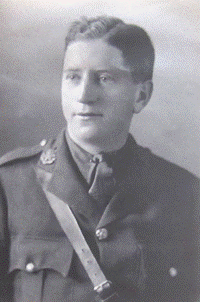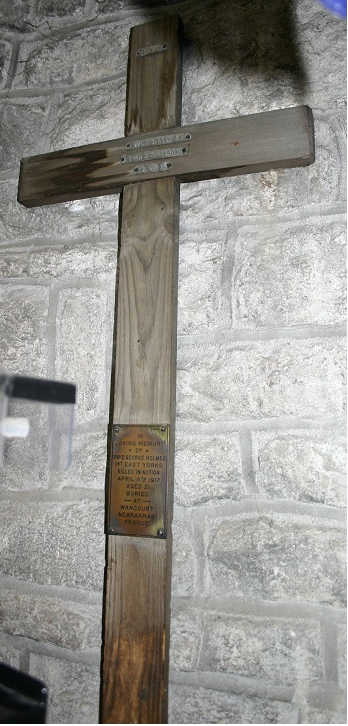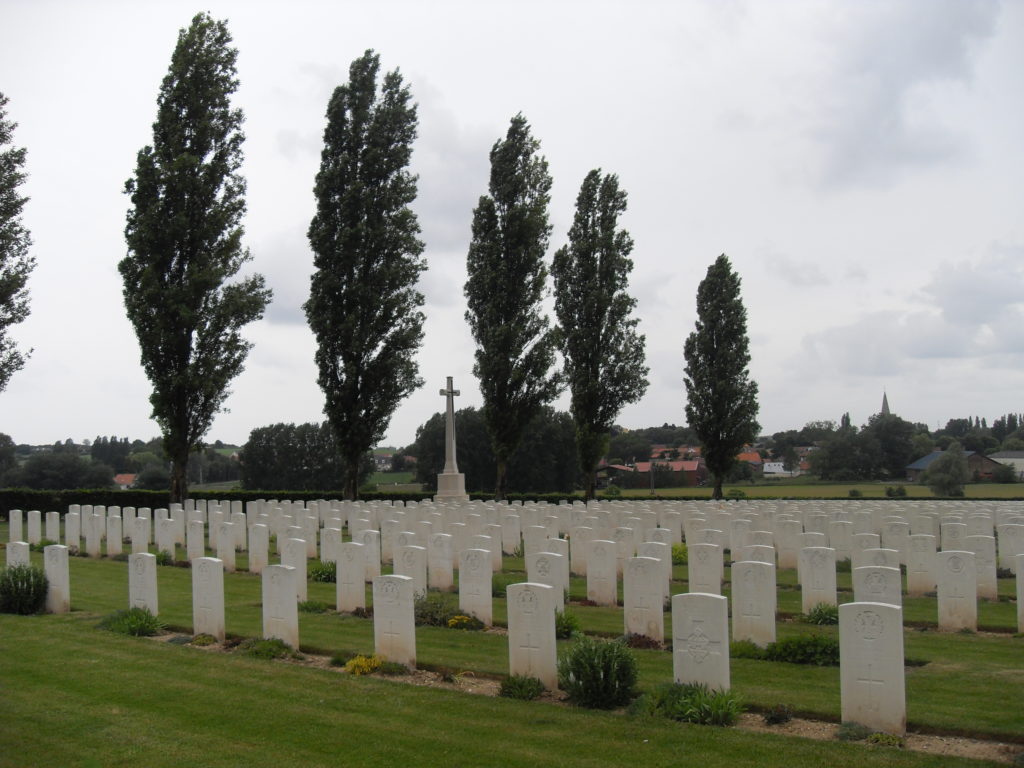Fact file:
Matriculated: 1914
Born: 28 October 1895
Died: 9 April 1917
Regiment: East Yorkshire Regiment
Grave/Memorial: Wancourt British Cemy; Grave VIII.A.7.
Family background
b. 28 October 1895 in Meersbrook Park, Sheffield, as the only child of Robert Wilson Holmes (1868–1954) and Sister [sic] Annie Holmes (née Hague) (1867–1951) (m. 1894). At the time of the 1901 Census the family was living at 87, Burcot Road, Norton, Derbyshire (no servants); by the time of the 1911 Census it had moved to 97, Burcot Road, Meersbrook, Sheffield (no servants); by 24 April 1917 it was living at “Ivylea”, Roslyn Crescent, Hathersage, Sheffield.
Parents
Holmes’s father was a carpenter and joiner and the son of John William Holmes (1843–1927), also a carpenter and joiner. His mother’s father, George Hague (b. c.1831) was at one time a joiner but became a farmer. John William left £3,554 9s. 10d. on his death in 1954.

George Holmes
(Photo courtesy of Magdalen College, Oxford).
Education
From 1906 to 1914 Holmes attended King Edward VII School, Sheffield, which had been established by the Sheffield City Council in 1905 by merging the Royal Grammar School (founded 1604) with Wesley College (founded 1837). He became Head of School (1913–14) and was followed in this position by Douglas Saville Thornton, played First XI football and cricket, and won the School Scholarship on the Higher Certificate examination with a Distinction in French. On 26 February 1914, James Harvey Hichens, MA (Oxon.) (later LLD; 1859–1938), the Headmaster of the Royal Grammar Sschool from 1905 to 1926, wrote President Warren a letter of recommendation for Holmes, in which he drew particular attention to the “pecuniary circumstances of [Holmes’s] parents […] which are such that he will have to practically maintain himself at the University”. Nevertheless, Holmes somehow put together the necessary sum of money, for he matriculated at Magdalen as an Exhibitioner in Classics on 13 October 1914, having been exempted from Responsions as he had an Oxford & Cambridge Certificate. He took half of the First Public Examination (Holy Scripture) in March 1915 but left without a degree at the end of Hilary Term 1915.
War service
Throughout his two terms at Magdalen, Holmes was a member of the Oxford University Officers’ Training Corps, and he applied for a Temporary Commission on 13 March 1915, shortly after leaving. On 8 April 1915 he was commissioned Second Lieutenant on probation with the 3rd (Reserve) Battalion of the East Yorkshire Regiment (London Gazette, no. 29,120, 6 April 1915, p. 3,422. Although he attended a Flying School in Scotland, he did not qualify as a pilot and went to France on 1 January 1917 to become an officer in the 1st (Regular) Battalion of the East Yorkshire Regiment, which had been in France as part of the 64th Brigade, 21st Division, since 26 November 1915.
Together with three other replacement officers, Holmes joined the Battalion when it was training at Fouquières, near Béthune, on 22 January 1917 and was assigned to ‘B’ Company. The Battalion then moved north-westwards to Wormhoudt, close to the Belgian border, on 29 January, and stayed there until 11 February 1917. It then moved back to Béthune and took up position in trenches at Cambrin, three miles to the east in a fairly quiet part of the front, on 14 February. On 22 February 1917 the Battalion was supposed to take part in a raid on the enemy trenches, but the mud was so bad that the men got bogged down, had to be dug out, and could not follow the creeping barrage. During March 1917 the Battalion worked on roads and a light railway at various remote places in north-western France before training at Berles-au-Bois, nine miles south-west of Arras, from 29 March to 3 April. After this it returned to the trenches eight miles south of Arras in the area of Hamelincourt-Boisleux-au-Mont, where, on 8 April, the Battalion assembled in Adinfer Wood, about five miles to the west of the front line.
In the afternoon of 9 April 1917, the first day of the Second Battle of Arras, the Battalion attacked the German positions in the northern sector of the newly created Hindenburg Line (14 March–5 April) and carried its first objective but not the second one, so “proceeded to consolidate”. During this opening phase of the Second Battle of Arras, which is known as the Battle of the Scarpe (9–14 April 1917), Holmes, who had been in the trenches only once before, was killed instantaneously by a shell, aged 21, after he had led his men across no-man’s-land and entered the German trenches somewhere in the area of Croisilles-Héninel. The attack cost the Battalion 12 officers and c.320 other ranks killed, wounded or missing and the village of Wancourt was not captured until 12 April. Holmes is buried in Wancourt British Cemetery, Grave VIII.A.7, which is inscribed: “He is not dead: such spirits do not die”.

Wancourt British Cemetery; Grave VIII.A.7
Holmes was one of four Head Prefects of the Royal Grammar School in Sheffield to be killed in action in World War One and is the only one of the four to have a marked grave; he is also commemorated by his original wooden grave marker, which hangs on the wall of the nave of Hathersage Church. He died intestate but his estate was valued at £327 19s. 5d.

His original wooden cross is in St Michael and All Angels Church, the parish church of Hathersage
(https://derbyshirewarmemorials.wikispaces.com)

Wancourt British Cemetery, designed by Sir Edward Lutyens (1869–1944)
Bibliography
For the books and archives referred to here in short form, refer to the Slow Dusk Bibliography and Archival Sources.
Printed sources:
[Thomas Herbert Warren], ‘Oxford’s Sacrifice’, The Oxford Magazine, 35, no. 17 (4 May 1917), p. 229.
[Anon.], ‘Holmes G.’ [obituary], The King Edward VII School Magazine, 4, no. 14 (July 1917), pp. 364–5.
Archival sources:
MCA: PR32/C/3/680-681 (President Warren’s War-Time Correspondence, Letters relating to G. Holmes [1914–1917]).
MCA: Ms. 876 (III), vol. 2.
OUA: UR 2/1/87.
WO95/2161.
WO339/50236.
